Relativistic Hartree–Fock model and its recent progress on the description of nuclear structure*
W H Long(龙文辉),J Geng(耿晶),J Liu(刘佳) and Z H Wang(王之恒)
1 School of Nuclear Science and Technology,Lanzhou University,Lanzhou 730000,China
2 Joint Department for Nuclear Physics,Lanzhou University and Institute of Modern Physics,CAS,Lanzhou 730000,China
3 Frontier Science Center for Rare Isotope,Lanzhou University,Lanzhou 730000,China
Abstract Regarding the stage progress on the relativistic Hartree–Fock (RHF) model achieved recently,we review the extensive developments of the model itself,including the descriptions of axially deformed unstable nuclei and nuclear spin-isospin excitations,which shows that a complete RHF framework is now available for exploring the tensor force effects in both ground state and excited states of unstable nuclei.Meanwhile,the recent RHF descriptions of the pseudo-spin symmetry restoration and the new magicity are also reviewed.It shows that the Fock terms,particularly theρ-tensor coupling and naturally introduced tensor force components,bring about significant improvements in maintaining the delicate in-medium balance of nuclear attractions and repulsions,and uniformly interpreting the emergence of new magicity in 52,54Ca.The revealed microscopic mechanisms not only deepen our understanding on the properties of nuclear structure,but also help to guide the further development of the effective nuclear force.
Keywords: RHF approach,tensor force,deformation,unstable nuclei
1.Introduction
With the worldwide developments of new generation radioactive-ion-beam (RIB) facilities and advanced nuclear detectors,the research of nuclear physics has been largely extended from a few stable nuclei to several thousand unstable ones,which enrich greatly the knowledge of nuclear physics[1–6].In contrast to the stable ones,plenty of novelties were successively found in unstable nuclei,such as nuclear halos[7–10],the emergences of new magicity and the disappearances of the traditional ones [11–18],etc.All these largely challenge our conventional understanding on nuclear physics.Moreover,many unstable nuclei are involved in the rapid neutron capture process (r-process),the crucial process of the synthesis of heavy elements,which reveals the special significance of unstable nuclei in understanding the origin of the elements in the universe [19,20].It calls for systematic and precise understanding on the structures,decays and reactions of unstable nuclei.However,as limited by the experimental conditions,it is still a long way to synthesize and precisely measure the relevant unstable nuclei,and the pioneering theoretical studies are necessitated.
Although the history of nuclear physics has been more than 100 years,it is still hard to describe precisely the properties of all the nuclides,due to the limitation on the understanding of nuclear force and nuclear many-body method.As generally recognized,nuclear force,a residual strong interaction,contains central,strong spin–orbit (SO)coupling,and non-central tensor force components,etc.Nowadays,the meson-exchange diagram [21]is one of the most successful interpretations of nuclear force.Based on different understanding on nuclear force and many-body method,people developed various nuclear theoretical models,including the ab-initio (see [22]and references therein),the configuration shell model [23–25],the non-relativistic and relativistic energy density functional (EDF) theories [26–34],etc.Restricted on the level of mean field approach,the mesonexchange diagram of nuclear force contains the Hartree and Fock terms,and the significantπ-meson contributes only via the Fock terms.As ones of the representative EDF models,the relativistic mean field (RMF) theory [30,31],containing only the Hartree terms of the meson-exchange diagram,owns the advantage of providing self-consistent treatment of strong SO coupling in nucleus,in contrast to the non-relativistic EDF models,and has achieved great success in describing plenty of nuclear phenomena [35–43].Moreover,incorporating with the Bogoliubov transformation,the RMF extension—the relativistic Hartree–Bogoliubov (RHB) theory [39,40,44–47]unifies the descriptions of both mean field and pairing correlations,and the continuum effects appearing in unstable nuclei are taken into account automatically,which promise the extensive reliability on describing unstable nuclei,e.g.the novel halo phenomena [48–52].Considering the deformation degree of freedom,the RHB models provide satisfied description on the axially deformed nuclei [46,47,51–56],under which a global nuclear mass table was obtained recently [57,58].However,as limited by the Hartree approach,the significant degrees of freedom associated with theπ-meson andρ-tensor couplings cannot be taken into account by the RMF models,in which the important ingredient of nuclear force—the tensor force components are also missing.
Implemented with the Fock terms,the relativistic Hartree–Fock (RHF) theory [32–34]can introduce naturally theπ-meson andρ-tensor couplings.While for a rather long time,the RHF models failed to provide reasonable quantitative description of nuclear structure properties,although people tried to introduce the non-linear self coupling ofσ-meson[59]or high order terms of the scalar field() [60]to evaluate the nuclear in-medium effects.Incorporating the density dependencies of the meson-nucleon coupling strengths for modeling the nuclear in-medium effects,it was eventually achieved to provide satisfactory description on nuclear properties by the RHF theory [61,62],with similar accuracy as the popular RMF models.Compared to the previous RHF models in [34,59,60],it indicates that the density dependencies carried by the meson-nucleon coupling strengths,the modeling of nuclear in-medium effects,are essential to achieve precise description of nuclear structure properties,after overcoming the numerical difficulties induced by the Fock terms.On the other hand,as indicated by recent applications [63],it seems that the completeness of properly evaluating the in-medium effects carried by all the meson-nucleon couplings can be also significant,which were only partly considered in [59,60].
Not only for implementing the meson-exchange diagram of nuclear force,significant improvements due to the Fock terms were also found on the self-consistent description of nuclear shell evolution[64–66],pseudo-spin symmetry(PSS)restoration[62,63,67,68]and symmetry energy[69,70],etc.In particular,the important ingredient of nuclear force—tensor force components can be naturally taken into account by the Fock terms[71–74].Together with the Lorentz covariance of the model itself,unified self-consistent treatments on both SO coupling and tensor force are achieved by the RHF theory,which is significant for the reliable description on the extension from the stable to unstable nuclei.Combined with the Bogoliubov transformation,the RHF extension—relativistic Hartree–Fock–Bogoliubov (RHFB) theory [75]provides reliable description on unstable nuclei,including the novel bubble structures [76,77],halo phenomena [78,79]and new magicity [80–82],etc.It is worth noting that the proton bubble structure in34Si predicted in [76]has been confirmed experimentally [83],and the mechanism responsible for the halo occurrences in Ce isotopes revealed in [78]interprets successfully the experimental results of neutron skin and pseudo-spin orbital splitting in the unstable nucleus78Ni [84].
Besides the ground state,the Fock terms in the RHF/RHFB models are also essential to provide self-consistent description of the excitation modes of nuclei.Among various nuclear excitation modes,the spin-isospin excitation is of special significance,because it may be tightly related with the intrinsic nuclear degrees of freedom associated with the orbit,spin and isospin,and carry plenty of spin-isospin information of nuclear force [85–88].Combined with the random phase approximation(RPA)and quasi random phase approximation(QRPA),the RHF and RHFB theories were extended to describe the nuclear spin-isospin excitations andβ-decays,respectively the RHF + RPA [89–92]and RHFB + QRPA methods [93,94].Due to the delicate balance in the Fock diagrams of isoscalar meson-nucleon couplings,both RHF + RPA and RHFB + QRPA methods provide fully self-consistent description of nuclear spin-isospin excitation using the same effective Lagrangian for both mean field and residual interaction [89,94],particularly for the precise reproduction of the fine structure of16O [91].Moreover,the existing experimental data ofβ-decay half-lives were also well reproduced by the RHFB + QRPA method after introducing neutron-proton pairing correlations,and a remarkable speeding up ofr-matter flow was predicted,which leads to enhancedr-process abundances of elements withA≿ 140
[93].Recently,the RHF + RPA method was implemented by considering the degrees of freedom associated with theρ-tensor couplings,and the effects of the tensor force components introduced by the Fock terms are analyzed,which indicates that the tensor forces play the role mainly via the RHF mean field rather than the RPA residual interaction in determining the Gamow-Teller resonances (GTR) [92].
As learned from both experimental and theoretical investigations,most of the nuclei in the nuclear chart,except a few nearby the magic numbers,are of the intrinsic shapes deviating the spherical symmetry,and the single-particle structures of finite nuclei can be notably changed with the development of the nuclear deformation.It also indicates the necessity of considering the deformation degree of freedom for reliable description of unstable nuclei.Recently,applying the expansion upon the spherical Dirac Woods–Saxon base[95],the axially deformed RHF and RHFB models,respectively referred as D-RHF and D-RHFB,have been established for axially deformed nuclei [96,97].Thus,a uniform description of SO coupling,tensor force,deformation,pairing correlations and continuum effects is achieved by the D-RHFB model,which provides reliable theoretical tool for exploring the properties of unstable nuclei in a rather wide range.As the first attempt,it was revealed in [96]that the tensor force components carried by theπ-pseudo-vector couplings can essentially change the shape evolution of the single-particle orbits,showing rather different systematics from the conventional nuclear models [96],which deserves more extensive exploration in unstable nuclei with the newly established D-RHFB model.
As a homage for the 40th anniversary of the Communications in Theoretical Physics,the recent progress on the RHF description of nuclear structure is reviewed in current article,including the extensive development of the RHF theory and the applications in describing the novelty of unstable nuclei.The review is organized as follows.After a brief recall on the RHF scheme in section 2,the complete RHFB frame and the RHF + RPA method with theρ-tensor coupling are introduced respectively in sections 3 and 4.Afterwards,sections 5 and 6 present the review on the novelty of unstable nuclei described by the RHF/RHFB theory,including the mechanism responsible for the PSS restoration,bubble structures and new magicity.In the end,the summary and perspective of the RHF description of unstable nuclei are given in section 7.
2.RHF approach
Under the meson-exchange diagram [21],nuclear force is assumed to be mediated by massive mesons.In practice,two isoscalar mesons(σandωμ)and two isovector onesof following quantum numbers (IP,τ) are considered as the effective fields to propagate the nucleon-nucleon interactions

whereI,Pandτare respectively the spin,parity and isospin of the mesons.Besides,the photon fieldμAis introduced for the Coulomb interactions between protons.In the context,we use arrows to denote the isovectors,and bold types for the space vectors.
For nuclear ground state,the meson-exchange diagram of nuclear force can be divided into two parts,the Hartree and Fock terms as shown in the left two plots of figure 1.In general,the retardation effects,the propagating time of the interaction,are ignored.Notice that the energy transfers involved in nuclear systems are much smaller than the masses of theσ-,ω-andρ-mesons with the magnitude of several hundred MeV.So that such approximation should be valid,and also to a less extent for theπ-induced interaction.Following the standard procedure as described in [34,97],the Hamiltonian of nuclear systems can be obtained as

whereφrepresents various two-body interaction channels,namely the Lorentz scalar (σ-S),vector (ω-V,ρ-V,A-V),tensor (ρ-T),vector-tensor (ρ-VT) and pseudo-vector (π-PV)couplings.The interaction vertexΓφ(r,r′)reads as
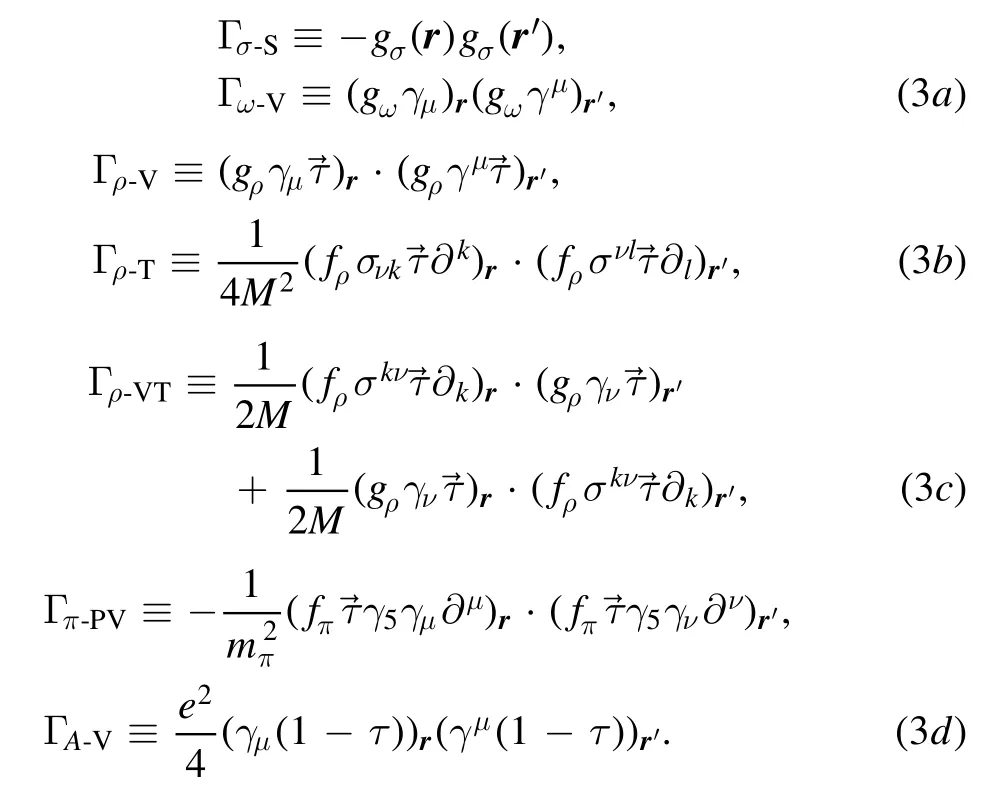
For the meson and photon fields,the propagatorDφis of the following form

where the retardation effects have been neglected.In the above expressions,Mandmφare respectively the masses of nucleon and mesons,andgφ(φ=σ,ω,ρ) andfφ′(φ′=ρ,π) are the meson-nucleon coupling strengths.
Consistent with the mean field approach,the no-sea approximation is considered as usual,which amounts to neglecting the contributions from the Dirac sea[35].Thus,in terms of the particle creation and annihilation operators,namelyαcandcα†defined by the positive-energy solutions of the Dirac equation,the Dirac fieldψthat describes nucleons can be quantized as

whereψαrepresents the Dirac spinor of the positive-energy stateα.With the no-sea approximation,the Hartree–Fock ground state of nuclear systems can be defined as


Figure 1.Feymann diagrams of the Hartree and Fock terms under the meson-exchange picture of nuclear force,and the deduced Hartree and Fock self-energies (SE).
where ∣-〉 is the vacuum state,andAis the number of nucleons.
Eventually,starting from the meson-exchange picture of nuclear force,combined with the quantization of nucleon field(5),the expectation of the Hamiltonian(2)with respect to the Hartree–Fock ground state∣HF〉 leads to the energy functionalEof nuclear systems [34,42]

including the kinetic energyEk,and the Hartree (Direct) and Fock(Exchange)terms of the potential energies from various coupling channelφ,respectivelyEDφandEEφ.
From the variation of the energy functional (7),the single-particle Dirac equations of nucleons can be derived,in which one can obtain two types of self-energies (SE),the local Hartree and non-local Fock ones;see the right two plots of figure 1.Obviously,it is not an easy task to handle with the Fock terms due to the non-locality shown in figure 1.It shall be reminded that in the RMF models,the so-called covariant density functional theory(CDFT),only the Hartree termsEDφare considered,and the degrees of freedom associated with theπ-PV andρ-T couplings,which contribute mainly via the Fock diagrams,cannot be taken into account efficiently.
3.RHF Bogoliubov scheme
For unstable nuclei,whose nucleon separation energies can be of the magnitude of less than1 MeV,the weak binding mechanism related to the pairing correlations and the continuum shall be treated carefully.Compared to the traditional BCS method,the Bogoliubov scheme has the advantage of uniformly dealing with both the mean fields and pairing correlations,as illustrated by the RHB models and the applications [40–42].As aforementioned,it is rather straightforward to derive the general formalism of the RHF theory using the concept of the HF single particle,that is defined by the solutions of the Dirac equation.However,it is not an apparent task to obtain a complete RHFB energy functional,or to quantize the Dirac spinor fieldψin the Bogoliubov quasi-particle space.Fortunately,a proper way was proposed recently in [97]to build a full RHFB energy functional by introducing new quantization form of the Dirac spinor field.
As well known,the Bogoliubov transformation defines the link from the HF particle to the Bogoliubov quasi-particle spaces,which reads as

whereβkandβ†kare respectively the annihilation and creation operators of the Bogoliubov quasi-particle.To avoid misleading,the indiceslandkare set to denote the HF singleparticle states and Bogoliubov quasi-particle states,respectively.Considering the requirement of establishing the Cooper pairs,the following specific relationships between the HF and HFB wave functions were suggested in [97]

to keep consistence with the expansions (5) and the Bogoliubov transformation (8),whereandhold for the timereversal partners of the single-particle and quasi-particle states,respectively.Subsequently,the quantization of the Dirac spinor fieldψin the Bogoliubov quasi-particle space is suggested as the following form

whereεkis the quasi-particle energy,andψUandψVare respectively theUandVcomponents of the quasi-particle spinors.For the HFB ground state∣HFB〉,it shall fulfill the following condition [98]

which is rather different from the HF ground state (6).From this condition,one may understand why it is not a trivial task to quantize the Dirac spinor fieldψ.
Applying the suggested quantization (11),the RHF Hamiltonian (2) of nuclear systems can be expressed as

in which the terms with zero expectation referring to∣HF>B are omitted.Obviously,the first two terms are respectively the kinetic and potential energy terms,and the last one accounts for the pairing correlations.Thus,without giving an explicit form of the HFB ground state,the full energy functional that contains both mean field and pairing correlations can be obtained from the expectation of the Hamiltonian (13) with respect to∣HFB〉.It gives

where the kinetic energyEk,the Hartree potential energyEφDand Fock oneEEφ,and the pairing energyEppφread as
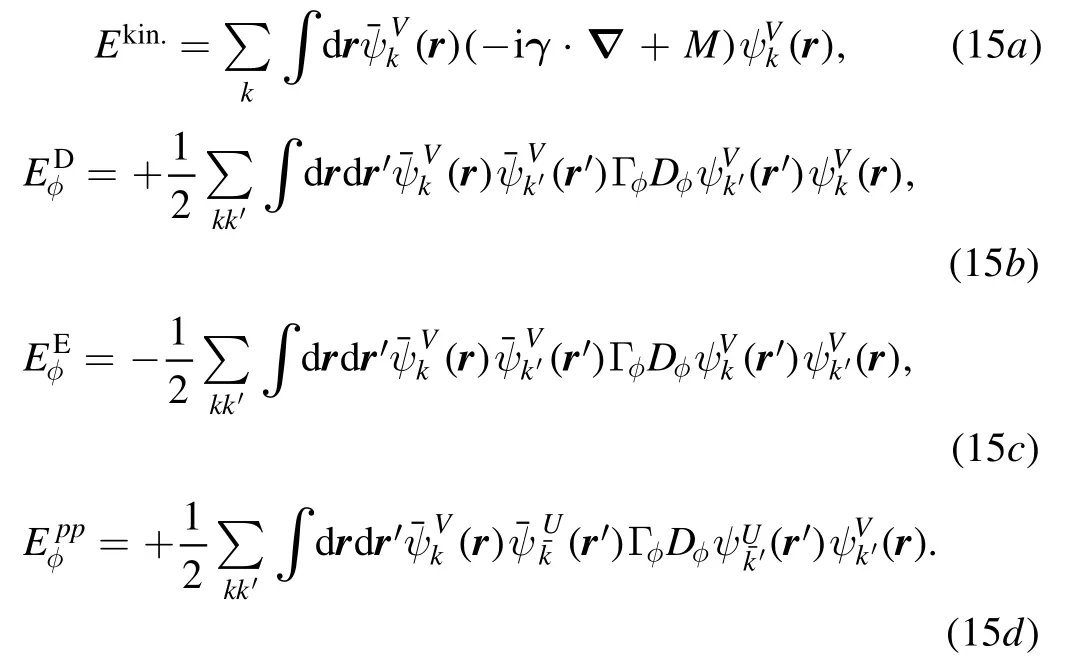
It shall be stressed that the potential energies,the twobody interactions,do give the Hartree and Fock potential terms,namely equations (15b) and (15c),while the pairing energy (15d) does not contain commutative antisymmetric contributions.In the RHFB and D-RHFB models,the finite range Gogny force D1S [99]is utilized as the pairing force,regarding the advantage of finite range of natural convergence with the configuration space.That is to say,the term ΓφDφ(r-r′)inEφppis replaced by(γ0)x(γ0)x′(r-r′),which is detailed in [97].
Besides the quantization of the Dirac spinor field,the variation of the RHFB energy functional(14)is also different from the RHF one(7),which is performed in general referring to the single-particle spinorψα.In contrast,one has to perform the variation with respect to the generalized density matrixR to get the full RHFB equation.Following the procedure detailed in [100],the density matrixR and derived quasiparticle Hamiltonian read as

whereρandкare respectively the density and pairing tensor,andhandΔ are respectively the single-particle Hamiltonian and pairing potential.Notice that there only existVcomponents in the kinetic and potential energies (15a–15c).If performing the variation with respect to the quasi-particle spinors,only the equations of theVcomponent can be derived.More seriously,one may deduce an additional factor 1/2 in the pairing potentialsΔ,which artificially reduces the pairing strength by half.In fact,some unitary condition of the Bogoliubov transformation,such asUV†+V*UT=0,cannot be properly taken into account when performing the variation with respect to the quasi-particle spinors.Previously,in order to get reasonable description of the pairing effects,people introduced the so-called exchange terms inΔ to implement such artificial reduction.
Similar to the RHF approach recalled in section 2,one can now derive the full RHFB scheme by cooperating with the Bogoiubov quasi-particle space,which shares the starting point with the RHF scheme.It provides a standard and apparent procedure for people to understand the Bogoliubov scheme which is very efficient and reliable in dealing with the unstable nuclear systems.Moreover,as the natural extension of the D-RHF model,the D-RHFB model for deformed unstable nuclei is presented in [97],in which a qualitative analysis on the nature ofπ-PV andρ-T couplings are presented.With such analysis,it becomes also apparent to understand the role played by theπ-PV andρ-T couplings in deciding the structures of deformed unstable nuclei.
4.RPA method based on the RHF approach
Among various excitation modes of nuclei,the spin-isospin excitation is of special significance,because it carries rich orbital,spin and isospin information of nuclear force.Combined with the (quasi) random phase approximation [(Q)RPA],the RHF and RHFB theories provide unified precise description of both ground state and spin-isospin excitation using the same effective Lagrangians for both mean field and residual interactions [89–91,93,94].As revealed from the non-relativistic investigations,the tensor force may play significant role in determining the excitation properties of nuclei and further theβ-decay [101–105].Even though,it still remains as an open question on the strength and even the sign of tensor force within the non-relativistic models.In contrast,it is demonstrated that not only theπ-PV andρ-T couplings,the Fock terms arising from the other meson-nucleon coupling channels also contain the tensor-force type contributions which exhibit characteristic spin dependence [71–74].
Aiming at the role of tensor force in determining the spin-isospin excitations,the RPA based on the RHF theory was extended recently by implementing the degree of freedom associated with theρ-T coupling [92].From PKO1 to PKA1,the self-consistency of RHF + RPA maintains well after implementing theρ-T coupling,which was demonstrated through the description of isobaric analog state [92].Taking the GTR as examples,it is illustrated that theρ-T andρ-VT couplings play significant role in maintaining the selfconsistency.Referring to the unperturbed results in figure 2,it is clear that the isoscalarσ-S andω-V couplings fully via the Fock terms present substantial contributions to thephresidual interactions,consistent with the previous conclusions in[89,91].Moreover,the isovectorρ-T andρ-VT couplings show more pronounced contributions than the isovectorρ-V andπ-PV ones,and the contributions from theσ-S andω-V channels become less remarkable.This is due to the fact that the balance between nuclear attractions and repulsion is notably changed by the strongρ-T coupling in PKA1 [63].

Figure 2.Transition strength distributions R- (MeV -1) of GTR in 208Pb as functions of the excitation energy E (MeV) given by RHF + RPA with PKA1,including the unperturbed results,the ones of the HF plus the ph residual interactions from the channels successively,and the full one.A Lorentzian smearing parameter Γ=1 MeV is used,and arrow denotes the experimental peak energy.The figure is taken from [92].
Applying the implemented RHF + RPA method,the tensor force effects on the spin-isospin excitations were also explored in[92].Taking208Pb as an example,figure 3 shows the GTR transition strengthsR-(MeV-1) as functions of the excitation energyE(MeV) calculated by RHF + RPA method using PKA1 and PKOi(i=1,2,3) [64],where ′′ 11′′,′′ 10′′,and′′ 00′′ represent the full calculations,the ones excluding the tensor force components in residual interaction,and the ones excluding the tensor force components in both mean field and residual interaction,respectively.As seen from figure 3,the RHF Lagrangians PKA1 and PKO series present similar description on the GTR of208Pb,and reproduce well the main peak (denoted by arrows),which further demonstrates the self-consistent persistence of the RHF + RPA method.More specifically,PKA1 slightly overestimates the peak energy,which is underestimated by all PKO Lagrangians.
Comparing the′′ 10′′ results to the full′′ 11′′ ones,it can be seen that the main peaks given by the selected RHF Lagrangians remain almost unchanged,and the low-energy peaks are solely moved towards the low-energy region slightly.This indicates that the tensor force components introduced via the Fock terms do not make significant contribution to thephresidual interactions.Further to the′′ 00′′ results,which neglect the tensor force components on both RHF mean field and RPA levels,the main peak given by PKA1 still remains unchanged,while PKO1 and PKO3 present upward shift of about 0.3 and 0.6 MeV,respectively,and a downward shift of about 0.4 MeV is obtained by PKO2.Such differences can be understood from the nature of tensor force components carried by the RHF Lagrangians PKA1 and PKOi(i=1,2,3).Specifically,PKA1 contains all the meson-nucleon couplings as described in equation (2),i.e.,theσ-S,ω-V,ρ-V,π-PV,ρ-VT andρ-T couplings,where as the PKO series do not contain theρ-VT andρ-T ones,and PKO2 even does not contain theπ-PV one.In fact,the signs of the tensor force components carried by various mesonnucleon couplings are not all the same [71,73,74,106].In short,the sign of tensor force inπ-PV coupling is opposite to those in theω-V,ρ-V,ρ-VT andρ-T channels.
For PKO1 and PKO3,the tensor force inπ-PV coupling dominates over those from all the other couplings,and it determines the whole sign of the tensor force [73].While for PKO2,only theω-V andρ-V couplings contain tensor force components.This means that the sign of the net tensor force in PKO2 is opposite to those in PKO1 and PKO3,which explains why the tensor-force effects in PKO2 are opposite to those in PKO1 and PKO3.In addition,it is known that the coupling strength ofπ-PV is larger in PKO3 than in PKO1,due to relatively weaker density dependence in PKO3[61,64].As a result,the tensor force components in PKO3 affect the GTR properties more remarkably than those in PKO1.For PKA1,the situation is more complicated.Compared with the PKO1 and PKO3,the tensor force arising from theπ-PV coupling in PKA1 is further cancelled by those from theρ-T andρ-VT ones.Thus,the tensor force components carried by PKA1 show almost invisible influence on the main peak of the GTR in208Pb.However,as revealed by the RPA calculations based on Skyrme Hartree–Fock (SHF + RPA)theory,the effects of tensor force in thephresidual interactions are rather considerable.In contrast to the results in figure 3,the calculation with the effective interactions SIII and SIII + T shows that the tensor force in the residual interaction can bring downwards the main peaks by about 4.1 MeV[101].If only neglecting the tensor force in the SHF mean field,the main peak is shifted downwards by about 0.8 MeV [101],which is qualitatively consistent with the tensor effects given by PKO2,but opposite to those in PKO1 and PKO3.
Different from the fully self-consistent RHF + RPA method,the tensor force in the SHF + RPA frame is treated as an individual degree of freedom,and the strength and even the sign of tensor force still remain as an open question.As aforementioned,the tensor force components are naturally introduced via the Fock diagrams under the RHF approach.Thus,after implementing theρ-T coupling,the fully selfconsistent RHF + RPA method lay the foundation of exploring the tensor-force effects in the spin-isospin excitations.In terms of those,it is expected to provide the subtle spin and isospin information of the in-medium interactions in nuclear systems.Moreover,the comparison and the further cross reference between the relativistic and non-relativistic researches shall promote our understanding not only on the nature of nuclear force,but also on the nuclear many-body method.
As mentioned in the introduction,the tensor force can play a critical role in determining the shell structure and the evolution [107–109].Although the Fock terms can get the tensor force component into account in a natural way,the strength of the tensor force is still not totally constrained in RHF theory.As stressed in a series of previous references,the key point to constrain the tensor force is to find uniquely sensitive observable [108].However,the single-particle energies,which are frequently adopted in the traditional strategy,may not be well justified,because the effects of particle-vibration coupling (PVC) also play crucial roles in the single-particle properties.In this situation,the ab initio calculation is promising to serve as reliable benchmarks and provide a bridge between the realistic nuclear forces and the effective ones[22,110].For example,the results obtained by the Brueckner Hartree–Fock calculation contain no beyondmean-field effects,and thus can be used as pseudo data to benchmark the DFT calculations [111].
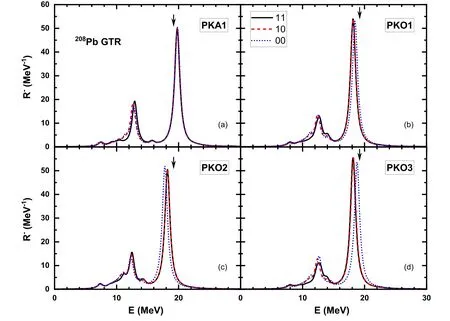
Figure 3.Transition strength distributions R- (MeV-1) in the T- channel of GTR in 208Pb as functions of the excitation energyE (MeV)given by RHF + RPA with PKA1 and PKO i (i=1,2,3).A Lorentzian smearing parameterΓ=1 MeV is used,and arrow denotes the experimental peak energy.The figure is taken from [92].
Recently,the self-consistent relativistic Brueckner-Hartree–Fock (RBHF) theory for finite nuclei has been established [112,113].Compared with the nonrelativistick BHF calculation using two-body interaction only,the RBHF achieved much better agreement with experimental data.The RBHF calculation was performed for the neutron drop[111,114],which is a collective of neutrons confined by an external field.Clear tensor-force effects were revealed on the evolution of SO splitting in neutron drops.Adopting these results as pseudo data,it was argued that the tensor force in the current RHF effective interactions seems too weak [111].Meanwhile,using the same pseudo data,weaker density dependence of theπ-PV coupling was suggested[115],which is related to the ‘tensor renormalization persistency’ [116]supported by the shell-model study.Within the non-relativistic DFT,a new Skyrme functional,namely SAMi-T,was developed under the guidance of RBHF calculations of neutron-proton drops [117].Similar progress was also made for the RHF effective interaction [118],which may guide the development of new RHF Lagrangian.
5.PSS in RHF
According to the effective field theory,nuclear force contains strong attractive and repulsive ingredients,which are described respectively by the exchanges of the scalar and vector mesons [119],and the delicate balance of the attractions and repulsions guarantees the binding of nuclear systems.Practically,such balance can be manifested as the conservation of the so-called PSS in nuclear structure,which is recognized as a relativistic symmetry [120–122].In the energy spectrum,the PSS corresponds to the quasi degeneracy of two singleparticle(s.p.)states with the quantum numbers(n,l,j=l+1/2) and (n-1,l+2,j=l+3/2),which form the pseudo-spin(PS)doublet(n′=n-1,l′=l+1,j′=j=l′± 1/2)[123,124],and the pseudo orbitl′ is nothing but the orbital angular momentum of the lower component of Dirac spinor [120].
Under the RMF scheme,the condition of the PSS conservation is verified asS(r)+V(r)=0 [120]or d[S(r)+V(r)]/dr=0 [125]withSandVrespectively for the attractive scalar and repulsive vector potentials.Obviously both conditions imply certain balance of strong attraction S(r)and repulsion V(r)in nuclear medium.However,in the RMF calculations and the RHF ones with PKOi(i=1,2,3),the PSS is often broken for the high-l′ PS doublet nearby the Fermi levels,inducing the spurious shell closuresN/Z=58 and 92 [62,78]and largely overestimated binding energies around140Ce (Z=58) and218U (Z=92) [126].Implemented with the degree of freedom of theρ-T coupling,such spurious shell closures were eliminated eventually by the RHF Lagrangian PKA1 that properly restores the PSS for the high-l′ PS doublets [65,78,80].
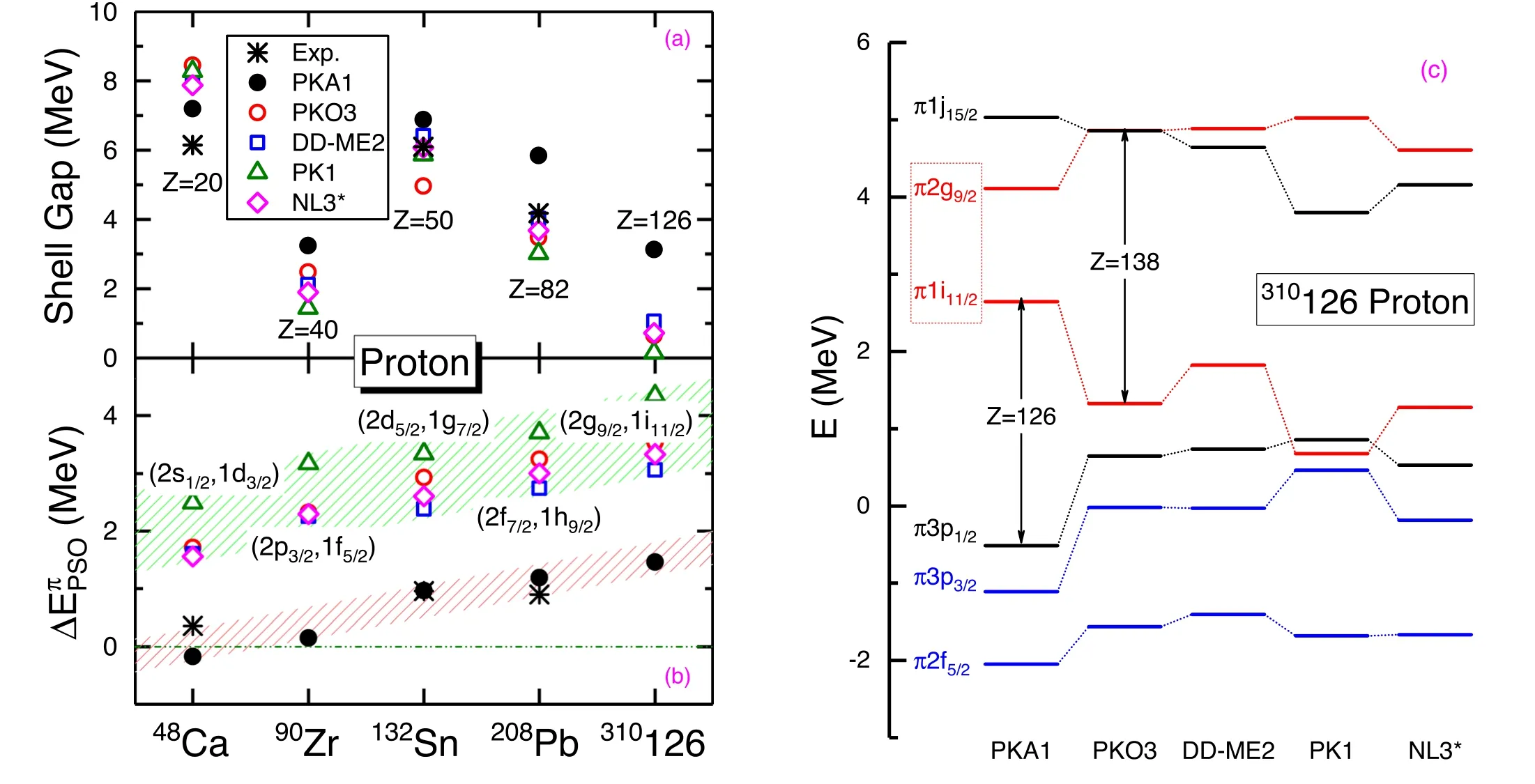
Figure 4.Proton shell gaps (MeV) [plot (a)]and the splittings of neighboring PS partners πEPSO (MeV) [plot (b)]for the traditional magic nuclei 48Ca,90Zr,132Sn,and 208Pb,and the super-heavy one 310126.Plot(c)shows the specifical energy spectrum of 310126.The results are calculated by PKA1 [62],PKO3 [64],DD-ME2 [127],PK1 [128],and NL3* [129].Plots (a) and (b) are taken from [63]with the experimental data from [130].
Taking the doubly magic nuclei48Ca,90Zr,132Sn,and208Pb,and the predicted superheavy one310126 as examples,the proton shells and the splittings of the PS doublets neighboring the shells given by the RHF and RMF models were analysed in[63]as shown in figures 4(a)and(b).It can be seen that the pseudo-spin orbital (PSO) splittingsΔEPSOshow nearly parallelled trends from the light to heavy nuclei between the models.Referring to the experimental data[130],only PKA1 shows appropriate agreements,where as the others distinctly overestimate the PSO splittings.This brings essential effects on the emergences of the neighboring shells in heavy nuclei.As a general trend of the models,less pronounced proton shellsZ=82 andZ=50 usually accom-
pany with largerΔEPπSOof the PS doublet (2f7/2,1h9/2) in208Pb and the one(2d5/2,1g7/2)in132Sn,respectively.Notice that the current analyses are restricted on the level of the mean-field approach.If going beyond the mean-field approach by considering the effects of the particle vibration coupling (PVC) [131],the single-particle levels may be shifted systematically toward the Fermi levels,and such effects are reduced in general when the distances to the Fermi levels are enlarged [132].Since the s.p.states that determine the shell gaps are either below or above the Fermi levels,the shell gaps in figure 4(a)will be squeezed by the PVC effects,which leads to further underestimated shellZ=82 for PKO3,DD-ME2,PK1 and NL3*.In contrast,because the relevant PS doublet orbits are either both above or below the Fermi levels,tiny PVC effects can be deduced for the PSO splittings in figure 4(b),which would not change the final conclusions.Extending to heavier nuclear systems,such as super-heavy nucleus310126predicted by PKA1 [80],it can be seen from figure 4(c)that well preserved PSS for the PS doublet(2g9/2,1i11/2) seems to approve the shellZ=126 in the PKA1 results.However for the other models,the large PSO splitting between the PS partners2g9/2and1i11/2gives massive shellZ=138.It indicates that the emergences of shell closures in superheavy nuclei may be essentially related to the PSS restoration.
As aforementioned,the conservation condition of the PSS indicates an in-medium balance of nuclear attractions and repulsions.Taking208Pb as an example,nuclear inmedium effects on the PSS restoration are demonstrated in[63],particularly for the high-l′ PS doublets.Figure 5 shows the proton (π) PSO splittingsΔEPπSOin208Pb as functions of pseudo orbitl′ given by the RHF Lagrangians PKA1 and PKO3,and the RMF one DD-ME2.As shown in figure 5,the splittingsΔπEPSOgiven by PKA1 decrease quickly with respect to pseudo orbitl′,leading to well conserved PSS atl′=4 which is consistent with the experimental data.In contrast,PKO3 and DD-ME2 present rather largeΔπEPSOvalues,inducing a spurious shellZ=92 [62].Such model deviations can be well interpreted by the sum contributionsEkin.+σ+ωof the splittingΔEPπSOfrom the kinetic term,and the dominantσ-S andω-V channels;see figure 5(b).It can be seen that the systematics of ΔπEPSOare almost fully determined by the sum contributionsEkin.+σ+ωwhich manifest the balance between the attractiveσ-S and repulsiveω-V couplings indeed.

Figure 5.Proton (π) pseudospin orbital (PSO) splittings ΔπEPSO (MeV)[plot(a)]in 208Pb as functions of pseudo-orbit l′,and the sum contributions from kinetic energy,σ,and ω potential energies Ekin.+ σ+ω[plot (b)].The results are extracted from the calculations with PKA1,PKO3,DD-ME2.The figure is taken from [63].
Moreover,as shown in figure 5(b),such balances are systematically changed from the RMF Lagrangian DD-ME2 to the RHF one PKO3 and further to PKA1,i.e.,the sum contributionsEkin.+σ+ωare successively reduced.In particular,thel′ dependencies are shifted nearly in parallel from DD-ME2 to PKO3.As demonstrated in figure 6(a)that shows the contributions of the binding energy of208Pb,all these imply the systematical changes on the balance between nuclear attractions and repulsions from the RMF to RHF approaches.In figure 6(a),all the effective Lagrangians give similar total binding energy for208Pb,while the specific contributions exceptEcou.are quite different.From the RMF to RHF approaches,the isovectorρ-andπ-couplings are notably enhanced by the Fock terms,leading to negatively largeEρ+πvalues in figure 6(a).Consistently,the dominant isoscalar termEkin.+σ+ωbecomes less negative to maintain the proper binding of208Pb.Within the RHF approach,due to theρ-T coupling in PKA1 that contributes a fairly strong attraction,the isovector termEρ+πbecomes much more negative from PKO3 to PKA1,and the negative isoscalar termEkin.+σ+ωis significantly reduced[63].All these indicate that the in-medium balance of nuclear attractions and repulsions is substantially changed by the Fock terms,particularly by the strongρ-T coupling in PKA1.
In fact,the presence of the Fock terms not only changes the balance of nuclear attractions and repulsions,but also bring notable consequences on the modeling of the nuclear inmedium effects,here evaluated by the density dependencies of the meson-nucleon coupling strengths in PKA1,PKO3 and DD-ME2;see figures 6(b)–(d).In figure 6(b),both the values and density dependencies of the coupling strengthsσgandωgare reduced from DD-ME2 to PKO3.As aforementioned,the Fock terms can considerably enhance the isovector channels,and thus the dominant channelsσ-S andω-V are not necessitated as strong as the ones in the RMF approach.Meanwhile,enhanced isovector channels can also take more in-medium effects into account.To provide proper modeling of nuclear in-medium effects,the density dependencies of the isoscalarσgandωgshould be reduced as well.It is also interesting to see from figure 6(b) thatσgandωgmaintain nearly parallel density-dependencies for both DD-ME2 to PKO3.Such situation is indeed common for the popular RMF Lagrangians and RHF ones PKOi(i=1,2,3).Further to PKA1,as revealed in figures 6(a) and (d),theρ-T coupling not only contributes fairly strong attraction,which can even shake the balance between the dominantσ-S andω-V channels,but also carries notable nuclear in-medium effects due to the remarkable density dependence.Thus,after implementing theρ-T coupling,the coupling strengthsσgandωgin PKA1 are further reduced,which even do not maintain the parallel density-dependent behaviors any more.
To qualitatively understand the consequence of the inmedium balance on microscopic nuclear structure,here on the PSS restoration,figure 7 shows schematic profiles of the matter density (ρb) and probability densities of thes-,p-,dandf-orbits.Combined with the results in figures 6,7 can help us to understand thel′-dependence of the PSO splitting ΔπEPSOin figure 5.From the central region to the surface of nucleus,the matter density varies from near saturated value to zero,and changes as well the in-medium balance of nuclear attractions and repulsions.Simultaneously,nucleons are driven outwards by the repulsive centrifugal potentials when the angular momentumlincreases.As described in figure 6(b),different density-dependent behaviors ofσgandωgindicate different balance betweenσ-S andω-V couplings from the center to the surface regions of nucleus.Following the schematic behaviors of the orbits in figure 7,it is not hard to deduce the fact that the in-medium balance of nuclear attractions and repulsions is manifested as thel′-dependence of theΔπEPSOvalues in figure 5,according to the conservation condition of the PSS.
Theρ-T coupling,which changes distinctly the in-medium balance,influence not only the structure of nucleus,but also the liquid-gas (LG) phase transition of thermal nuclear matter that has important impact on the heavy-ion collisions[134–137],nuclear astrophysics[138–142],and so on.Under the RMF and RHF approaches,there are also lots of investigations on the LG phase transition [143–148].Different from those,the consequences of the in-medium balance were clarified recently in [133]by applying the RHF model with PKA1.As shown in table 1 and figure 8,PKA1 that contains theρ-T coupling predicts rather different critical properties and LG phase diagrams from the other effective Lagrangians.As demonstrated in [133],the in-medium balance of nuclear attraction and repulsion,manifested as various modeling of the nuclear in-medium effects,is essential for the van der Waals-like behaviors of thermal nuclear matter,in which the residual nuclear in-medium effects carried by the balance of the dominant channels play a significant role [133].
Enlightened by the PSS restoration and nuclear in-medium effects,the new relativistic mean-field Lagrangian DDLZ1 is proposed in [149].For the new effective Lagrangian DD-LZ1,the density dependencies ofσgandωgdo not maintain parallel,which is deduced by ignoring the conditiongσ′′(1)=gω′′(1)in the parametrization of DD-LZ1.Benefited from that,DD-LZ1 cures the common disease in previous RMF calculations,namely the occurrences of the spurious shell closuresN/Z= 58 and 92,as shown in figure 9.Consistently,DD-LZ1 also restores the PSS for the high-l′pseudo-spin doublets nearby the Fermi levels,which indeed approves the effectiveness of the analysis for the PSS restoration and nuclear in-medium balance between nuclear attraction and repulsion.Moreover,better accuracy obtained by DD-LZ1 in describing nuclear mass is quite desirable for further applications [149].

Figure 6.Plot(a)shows the contributions to the binding energy(MeV)of 208Pb from the kinetic and isoscalar potential energies(Ekin.+ σ +ω),the isovector potential energies( Eρ +π),and the Coulomb ones(Ecou.),calculated by PKA1,PKO3,DD-ME2.Plots(b)–(d)show the isoscalar coupling strengths gσ and gω [plot(b)],and the isovector ones gρ [plot(c)], fπ and fρ (к ρ=fρ /gρ)[plot(d)]as functions of baryon densityρb(fm-3) given by PKA1,PKO3 and DD-ME2.The figure is taken from [63].
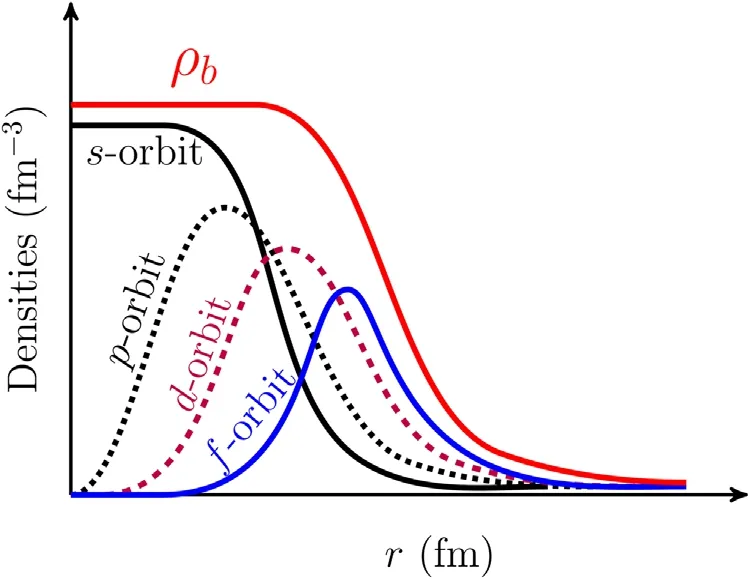
Figure 7.Schematic diagrams of the matter densityρb and probability densities of the s-, p-, d-and f-orbits.
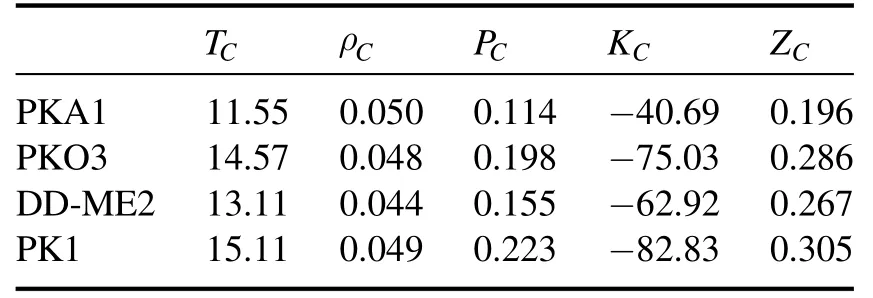
Table 1.Critical parameters of LG phase transition for symmetric nuclear matter,i.e.,the critical temperature TC (MeV),critical density ρC (fm-3),critical pressure PC (MeV fm-3),critical incompressibility KC (MeV),and compressibility factor Z>C.The results are calculated by the RHF functionals with PKA1,PKO3 and RMF functionals with DD-ME2,PK1.This table is taken from [133].
6.New magicity N=32 and 34 and Novelty in 48Si
As one of the milestones in nuclear physics,the traditional magic numbers and shell structures were explained by introducing the empirical spin-obit coupling in atomic nuclei[151,152].With the development of RIB facilities,the new magicity were found in unstable nuclei such asN=16 in drip-line nucleus24O [13,153],which attracted intensive interests.As another typical example,the magic nature ofN=32 and34 has been confirmed experimentally by the enhanced+21excitation energy and the relatively reducedB(E2;0+→21+)transition probabilities [18,154–158].Theoretically,the tensor force is recognized to play an important role in determining the shell evolution and the formation of new magicity due to its spin-dependent feature [72,73,107].
Compared to the other popular models,the RHF and RHFB models provide reliable tools to verify the underlying mechanism of the emergence of new magicity,since both SO coupling and tensor force,the important ingredients of nuclear force,can be uniformly treated under the RHF approach [72–74].As indicated by the study along the isotonic chains[81],which shows that the new magicityN=32 and34 can be uniformly described by the RHFB theory with PKA1,the Lorentzπ-PV andρ-T couplings seem to play a determinant role in the formation of the subshellN=32,but negligible for the oneN=34.
Inspired by later high precision mass measurements[160–162],particularly the first direct mass measurements of neutron-rich calcium isotopes beyond neutron number 34[159],the mechanism accounting for the occurrence of new magicityN=32 and34 was verified by applying the RHF model with PKA1 [82].As shown in figure 10(a),the significant drops of the two-neutron separation energiesS2n(MeV) across traditional magic numberN=28 and the new onesN=32 and 34 can be well reproduced by PKA1,although the values are systematically overestimated.Moreover,for the empirical energy gapδeand two-neutron gapΔ2nrespectively shown in figures 10(b) and (c),the PKA1 calculations also show precise agreement with the data atN=28,32 and 34.In contrast,the S 2nvalues calculated by PKO3 and DD-ME2 decrease smoothly fromN=30 toN=40,and theδeandΔ2nvalues are also distinctly underestimated.

Figure 8.LG phase diagrams of thermal nuclear matter at the temperatures T = TC,11,10,9,and 8 MeV,calculated by the RHF Lagrangians PKA1 [plot (a)]and PKO3 [plot (b)].This figure is taken from [133].
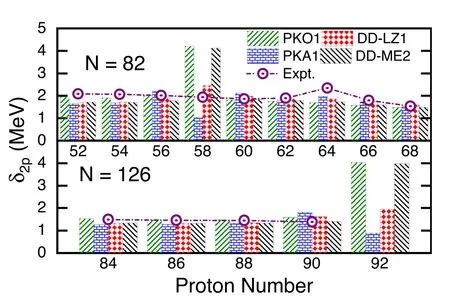
Figure 9.Two-proton shell gapδ2p for N= 82 (up panel) and 126 (down panel) isotonic chains obtained from RH(F)B calculations with the new effective interaction DD-LZ1.For comparison,the experimental data[150]and calculated results of PKA1,PKO1,and DD-ME2 are also given.The figure is taken from [149].
Not only the precise mass measurement,the quasi free neutron knockout experiment from54Ca also corroborates the shell closure atN=34 [163].To clarify the mechanism for the successive magicityN=32 and 34,figure 11 gives the single particle energy referring to the neutron (ν) orbit ν1f7/2and the density distribution of neutron and proton for52,54Ca calculated by PKA1.It is seen that both the neutron and proton densities of52Ca show distinct central-bumped structures,being consistent with the large SO splitting ofν2porbits,which leads to theN=32 shell closure.When theν2p1/2orbit is populated,the density profiles of54Ca become central-depressed,even showing a neutron semi-bubble structure,and consistently theν2psplitting is reduced.Combined with the unchangedν1fone,this reduction gives the subshellN=34.
Considering the fact that the SO potential can be expressed in terms of the derivative of nuclear densities[151],it is not difficult to understand the evolution of theν2psplitting that depends sensitively on central density profiles[164].Experimentally,a reducedν2psplitting,attributed to the proton bubble structure,has been observed by comparing the spectroscopic information on the35Si and37S isotones[165].However,it should be noted that the bubble structure arise generally from a reduced occupation of thes-orbits.For example,the one-proton removed reaction experiment shows that the proton(π)orbitπ2s1/2is essentially empty to give the proton bubble structure in34Si [76,83].However from52Ca to54Ca,the occupations ofs-orbits do not change due to the robust magic core48Ca.
As the further verification,the interaction matrix elements between the valence orbitν2p1/2and the others were analyzed in [82]by using the RHF Lagrangians PKA1,PKO3,and the RMF one DD-ME2,see figures 12(a)–(c).It is interesting to see that the interaction betweenν2p1/2ands-orbits are generally repulsive,and PKA1 presents the strongest repulsive results.Thus,when theν2p1/2orbit is populated in54Ca,such strong repulsive interactions given by PKA1 drive thes-orbital nucleons away from the center to reduce the central densities as shown in figure 11,and consistently theν2psplitting is reduced to form the subshellN=34 in54Ca,since theν1forbits are not sensitive to the alteration of central densities.
It shall be mentioned that within the relativistic scheme,e.g.the RMF and RHF approaches,the Dirac spinors of nucleons contain the upper(U)and lower(L)components.In particular,theL-components of thep1/2orbits share the same angular wave functions with theU-ones of thes1/2orbits,and vice versa.Such doublets are named as the Dirac inversion partners (DIPs) in [82],which are of the same total angular momentum but opposite parity.To understand the repulsive couplings between the DIPs,here (ν2p1/2,νs1/2),the total interaction matrix elements are decomposed into two parts,theUL-terms andUU-terms as shown respectively in figures 12(b) and (c).For theUU-term,it contains the contributions only from theU-components of Dirac spinors,while theL-components contribute theUL-terms,namely the ones which exclude theUU-terms from the total.
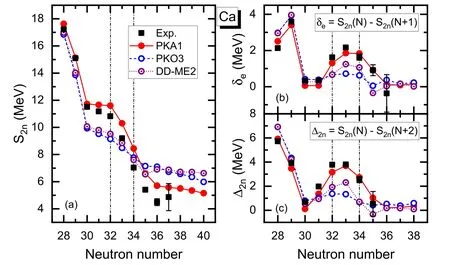
Figure 10.Plot(a) shows two-neutron separation energies S 2n (MeV) of Ca isotopes,and plots (b) and (c) for the differences,respectively δe=S2n(N)-S2n(N+1) and Δ2n=S2n(N)-S2n(N+2) The results are calculated by PKA1 [62],PKO3 [64]and DD-ME2 [127],as compared to the data [150,159].The figure is taken from [82].

Figure 11.3D Neutron/proton densities(left panels)and neutron(ν)single-particle levels(right panels)for 52,54Ca,calculated by PKA1.For the illustration,the last row shows the calculation for 54Ca that drops the UL-terms felt by the s-orbits from the DIPν2p1/2.The figure is taken from [82].
As shown in figure 12(b),theUL-terms present repulsive contributions,which are notably enhanced for the DIPs due to the inversion similarity,i.e.,theU-/L-components ofν2p1/2orbit and theL-/U-ones of its DIPss1/2share the same angular momentum.Such that the interactions between the DIPs (ν2p1/2,νs1/2) are repulsively enhanced by the strongUL-terms,eventually giving the strong repulsiveVs1/2,ν2p1/2in figure 12(a),the key mechanism accounting for the shell closureN=34 in54Ca.As an implemented illustration,the repulsiveUL-terms inVν2p1/2,νs1/2are dropped for the calculation of54Ca,as shown in the last row of figure 11(marked as54Ca*).It can be seen that without the repulsive effects between the DIPs,the central-bumped structures similar as52Ca appear in both neutron and proton densities,and consistently theν2psplitting becomes large enough to eliminate theN=34 subshell.
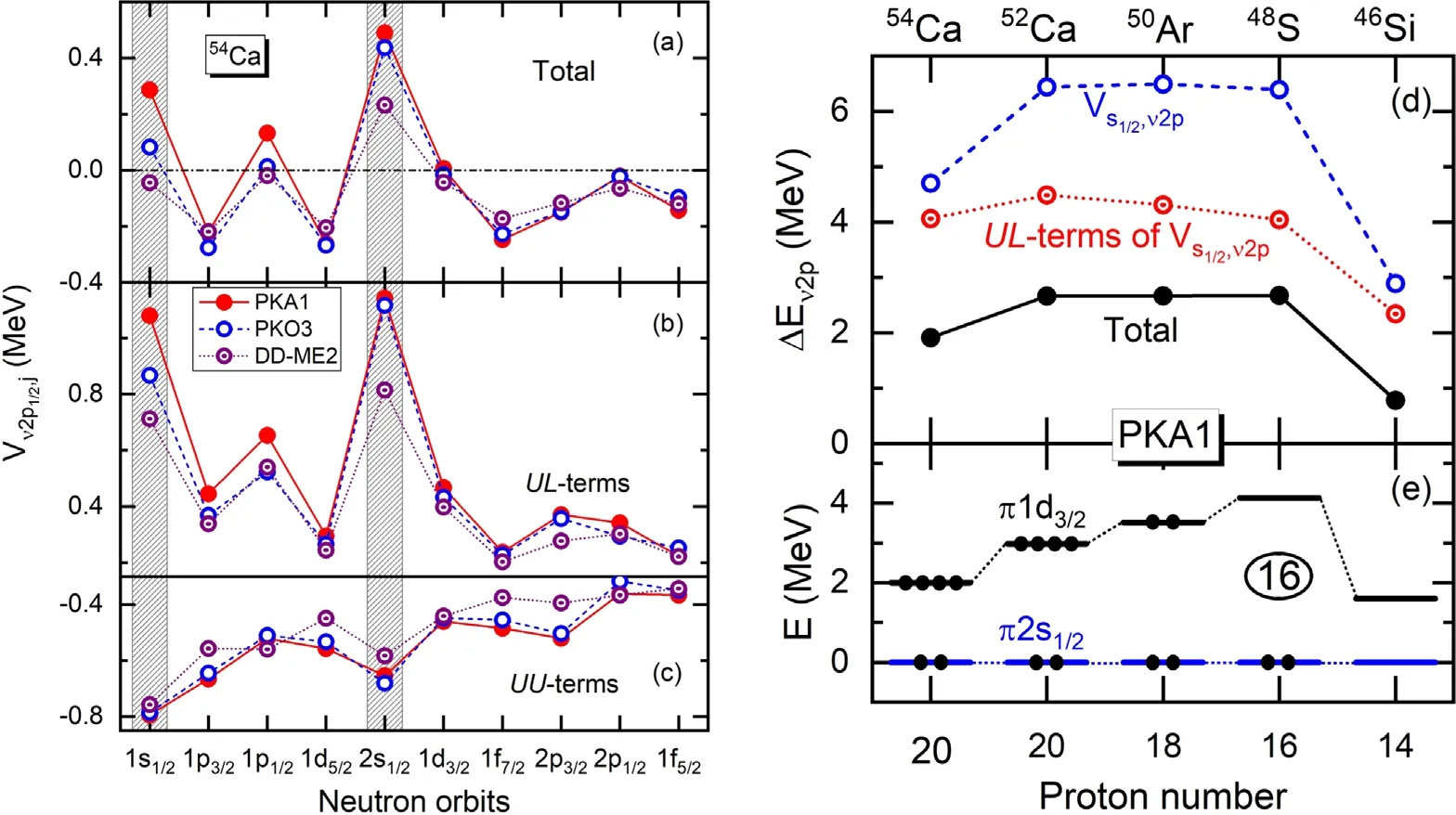
Figure 12.Interacting matrix elements between the valence neutronν2p1/2 orbit and the neutron ones calculated by PKA1,PKO3 and DDME2,namely Vν 2p1/2,j (MeV),including the total[plot(a)],the UL-terms[plot(b)]and UU-terms[plot(c)].Plot(d)shows the ν2p splittings from 54Ca to 52Ca and further from 52Ca to 46Si along the isotonic chain of N=32.Schematically,plot (e) shows the proton orbitsπ2s1/2 and π1d3/2,in which the black circles denote the protons occupying the orbits.The figures are taken from [82].

Table 2.Contributions from the Hartree (H) and Fock (F) terms of theσ-scalar (σ-S),ω-vector (ω-V),ρ-vector (ρ-V),ρ-tensor (ρ-T),ρ-vector-tensor (ρ-VT) and π-pseudo-vector (π-PV) couplings to the interaction matrix element Vν 2 p1/2,ν1s1/2 (MeV),including the UU-,UL-terms and the total (V).The results are calculated by PKA1.
As seen from figure 12(b),theUL-terms are in general repulsive,and such systematics can be qualitatively explained by the nature of the coupling channels.As an illustration,table 2 shows the Hartree (H) and Fock (F) contributions to the interaction matrix elementVν2p1/2,ν1s1/2(MeV) for various channels,including theUU-,UL-terms and the total (V).For the selected mesonic degrees of freedom,the isoscalarσ-S andω-V couplings dominate respectively the attraction and repulsion,and the cancellation between each another gives residual attraction.However,due to the specific nature of Lorentz scalar coupling,theσ-S coupling shows similar repulsiveUL-terms as theω-V one,instead of counteracting each another,seeingUL-H terms in table 2.It shall be emphasized that repulsiveUL-terms are obtained for both the neutron-neutron and proton-proton couplings,as both are dominated by theσ-S andω-V couplings.
Compared to the ordinary cases,the repulsiveUL-terms are strongly enhanced for the DIPs (ν2p1/2,s1/2),which can be understood well from the inversion similarity between the DIPs,i.e,theU-/L-components ofν2p1/2orbit and theL-/U-ones of its DIPss1/2share the same angular momentum.From the RMF to RHF approaches,new couplings between theU-andL-components of Dirac spinors are introduced by the Fock terms,such as the space parts of the vector couplings(ω-V andρ-V),and theρ-VT one and the time component ofρ-T one in PKA1,which enhance the repulsiveUL-terms by different extent,see table 2.Thus,the RHF models present more repulsiveUL-terms for the DIPs than the RMF ones.However,for the enhanced repulsion between the DIPs (ν2p1/2,νs1/2)from PKO3 to PKA1 in figure 12(b),one cannot simply attribute to the effects of the additionalρ-T andρ-VT couplings,and it is indeed due to different in-medium balance between nuclear attractions and repulsions given by PKA1 from PKO3 as aforementioned and clarified in [63].

Figure 13.Neutron(ν)/proton(π)density distributions(a)and neutron single-particle spectra(b)for 48Si and 54Ca,calculated by RHFB with PKA1.The compositions of ν2p and ν 1f for 48Si are also shown.The figure is taken from [77].
Qualitatively,the connection between bubble structure and SO splitting could be understood well in terms of SO potential.As indicated from figures 12(a)–(c),theUL-terms of the DIPs’ couplings,here the doublets (s1/2,ν2p1/2),are largely enhanced,compared to the others,e.g.the(s1/2,ν2p3/2)couplings.Thus,it is appealing to understand the effect of strong coupling of DIPs in determining the SO splitting ofν2pstates,e.g.the subshellN=32 from the angle of two-body interaction.Figure 12(d) shows the evolution of ΔE ν2pvalues (MeV),as well as the contributions from the couplings with thes-orbits(Vs1/2,ν2p)and theirUL-terms.It can be seen that thes-orbital contributions,which are dominated by theUL-terms,play a determinant role for giving notableν2psplitting,namely the subshellN=32.On the protondeficient side,the subshellN=32 maintains until48S due to thes-orbital contributions.However,it should be noted that the proton magic shellZ=16,shown in figure 12(e),is the key to assure the full occupation of the proton(π)orbitπ2s1/2orbit in both50Ar and48S.
In fact,the experimental low-lying structure of50Ar has been investigated and the calculation of modified SDPF-MU effective interaction indicated that the magnitude of theN=32 subshell gap in50Ar is similar to those in52Ca[18].From52Ca to54Ca,the occupation of valence neutron on theν2p1/2orbit drives thes-orbital neutrons far away from the center and then weaken its contribution to the splitting ofν2pstates,which eventually lead to a prominent subshell atN=34.Combined with the results in figures 11 and 12,it can be seen that either the emergence of new magicityN=34 in54Ca or the persistence of theN=32 subshell from48S to52Ca,as well as its quenching in46Si,are originated from the presence/vanishing of the strong repulsive effect between the DIPs (s1/2,ν2p1/2).
As mentioned above,the bubble structure could arise from the reduced occupation ofs-orbits ors-orbital nucleons driven away from the center of nucleus.Extending along theN=34 isotonic chain by reducing the proton number,it is found that the drip-line isotone48Si shows several novelties,including the doubly magicityN=34 andZ=14,dual(neutron and proton) bubble structures,and the reentrance of pairing correlations if thermally excited [77].As shown in figure 13,the atypical nucleus48Si exhibits dual semi-bubble structures according to the calculation of PKA1.As confirmed by the extensive precision electron scattering,the central densities of stable nuclei are almost constant asρ0≈0.16 fm3,independent of the mass number [166].However,as shown in figure 13(a)the central densities of48Si are much lower than those of54Ca,which refresh our understanding to the incompressibility of atomic nuclei and the saturation of nuclear force.On the other hand,it should be noted that such dual semi-bubble structure cloud weaken substantially the splitting ofν2pstates and further stabilize this extreme neutron-rich nucleus at the drip line[77].Taking48Si as an example,the theoretical study of proton-induced reactions shows that the emitted protons are distinctly enhanced along the beam direction with a bubble configuration in the target [167].
7.Summary and perspective
In this paper,we review some recent progress on the RHF description of nuclear structure,including the extension for axially deformed nuclei and nuclear excitations,and the applications in describing the restoration of PSS and the novelty in unstable nuclei.Basically the complete frameworks,such as D-RHF and D-RHFB models,and RHF + RPA method withρ-T couplings,for describing both unstable nuclei and nuclear spin-isospin excitation are available now,which have the advantages of full self-consistence.Taking the PSS restoration and the new magicity as examples of the applications,it is shown that theρ-T coupling that contributes mainly via the Fock diagram plays an important role in maintaining the delicate balance of nuclear attractions and repulsions,which are manifested as the proper restoration of the PSS for the high-l′ PS doublet and uniform interpretation of the new magicityN=32 and34 in52,54Ca.To a certain extent,the revealed mechanisms help us much to understand the nature of nuclear force under the relativistic scheme,which is of special significance to guide the further development of the effective nuclear force.
Since the full scheme of the RHF models,including the extensions associated with the Bogoliubov transformation,RPA method and the deformation,is valid as proved from the pioneer applications,it is also expected for the extensive explorations such as the role of tensor force components carried by the Fock terms in determining the structure of deformed unstable nuclei and superheavy ones,as well as the spin-isospin excitations and nuclearβ-decays.On the other hand,benefiting from the experiences in developing the D-RHF and D-RHFB models,it also becomes natural to consider the degree of freedom of the octuple deformation as the further development of the models.All these may help us to understand more deeply the nature of nuclear force and the properties of unstable nuclei in a wide range.
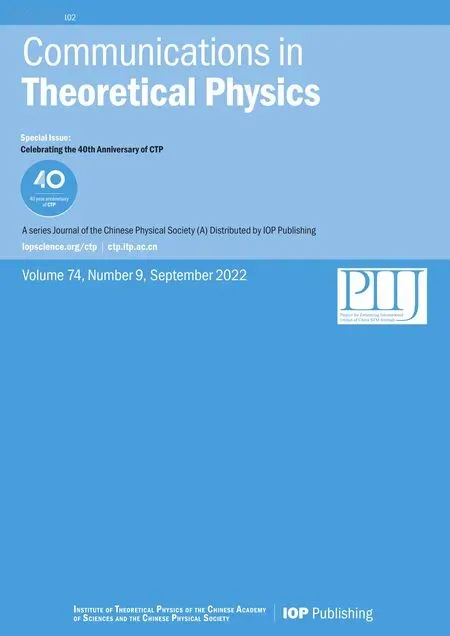 Communications in Theoretical Physics2022年9期
Communications in Theoretical Physics2022年9期
- Communications in Theoretical Physics的其它文章
- Vector semi-rational rogon-solitons and asymptotic analysis for any multicomponent Hirota equations with mixed backgrounds
- High precision solutions to quantized vortices within Gross–Pitaevskii equation
- Quantum dynamics of Gaudin magnets
- Realizing number recognition with simulated quantum semi-restricted Boltzmann machine
- A prototype of quantum von Neumann architecture
- PV-reduction of sunset topology with auxiliary vector
